Conozcamos el Péndulo de Newton // Let's get to know Newton's Pendulum
7 comments
¡Hola querida comunidad científica de #Hive, reciban todos un cordial saludo!🖐
Hello dear #Hive scientific community, receive warm greetings from all of you!🖐
El pasado domingo estuve de paseo por uno de los centros comerciales de la ciudad donde vivo, y en dicho paseo me tope con un objeto muy hermoso, en realidad es algo decorativo, así que decidí adquirirlo para colocarlo en mi nueva oficina. Se trata de una Cuna de Newton y aprovechando que tengo una, decidí escribir una publicación acerca de ella y de los principios físicos que se pueden observar.
Last Sunday I was walking around one of the shopping malls in the city where I live, and in that walk I came across a very beautiful object, actually it is something decorative, so I decided to buy it to place it in my new office. It is a Newton's Cradle and taking advantage of the fact that I have one, I decided to write a post about it and the physical principles that can be observed.
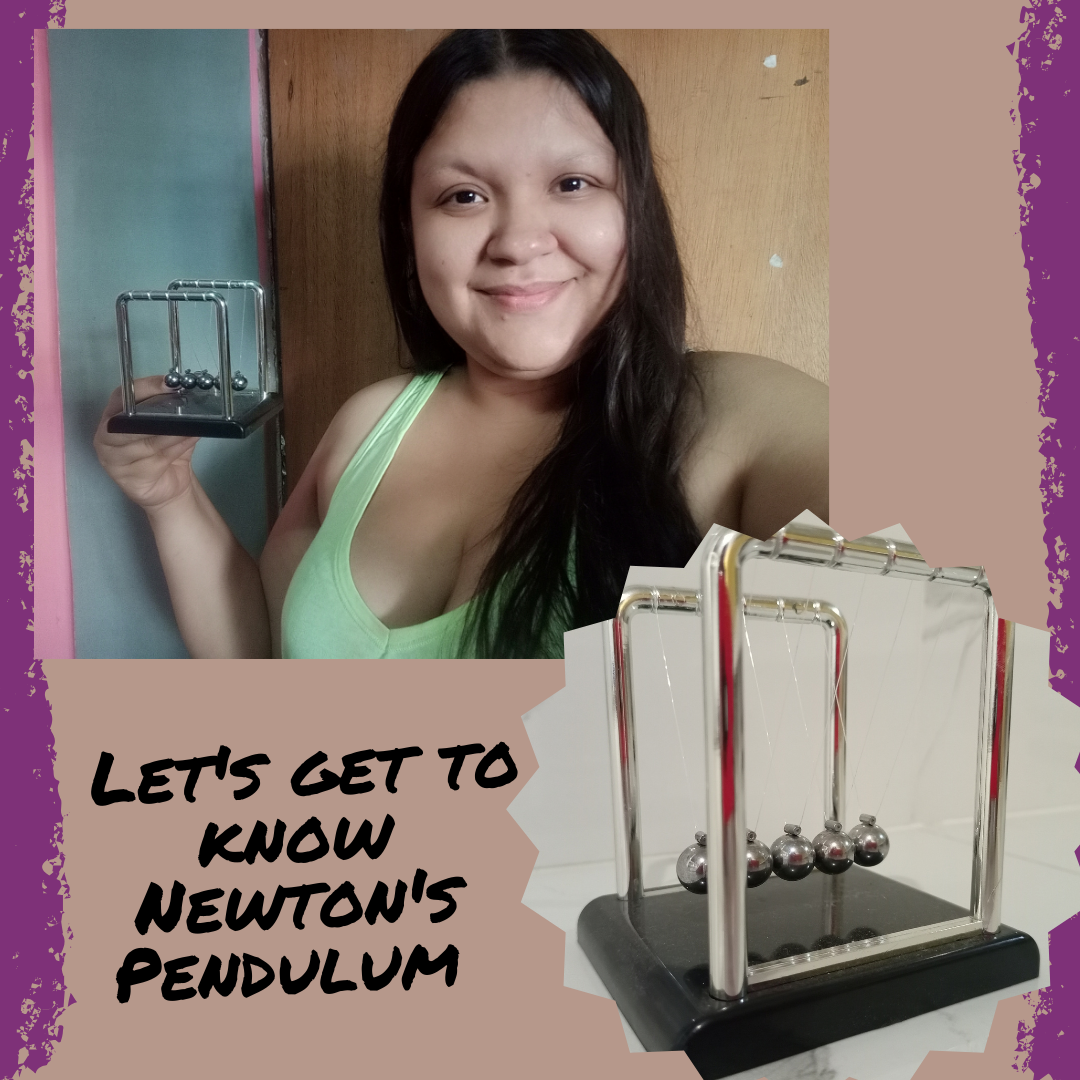
Conocido como el Péndulo de Newton, la Cuna de Newton o Pelotas de Newton es un dispositivo mecánico simple creado en el año de 1967 por en inglés Simón Prebble y su nombre es en honor al famoso físico Isaac Newton ya que se utiliza para explicar las Leyes de Newton, el Principio de la Conservación de la Energía y de la Cantidad del Movimiento.
En realidad este dispositivo es considerado un juguete de escritorio, de hecho los primeros juguetes realizados fueron construidos en madera, pero luego se realizaron diseños en versión cromada por el escultor Richard Loncraine. No obstante existe un péndulo de Newton súper grande, el cual se encuentra en Kalamazoo, Michigan; está en una exhibición pública y es utilizado para demostraciones científicas. Está constituido por 20 esferas las cuales tienen una masa de 6.8 kilogramos, las mismas se encuentran suspendidas por cables de metal con una longitud de 6,1 metros.
Known as Newton's Pendulum, Newton's Cradle or Newton's Balls is a simple mechanical device created in 1967 by the Englishman Simon Prebble and named after the famous physicist Isaac Newton as it is used to explain Newton's Laws, the Principle of Conservation of Energy and Quantity of Motion.
Actually this device is considered a desktop toy, in fact the first toys made were built in wood, but later designs were made in chrome version by the sculptor Richard Loncraine. However, there is a super large Newton's pendulum, which is located in Kalamazoo, Michigan; it is on public display and is used for scientific demonstrations. It consists of 20 spheres which have a mass of 6.8 kilograms and are suspended by metal cables with a length of 6.1 meters.

Ahora bien, este dispositivo está constituido generalmente por cinco esferas idénticas; las mismas se encuentran suspendidas por cuerdas de modo tal que las bolas se encuentran alineadas de manera horizontal. Los hilos que suspenden las esferas deben ser de igual longitud e inclinados al mismo ángulo, esto con la intención de restringir el movimiento de las esferas en un mismo plano vertical.
Now, this device is generally constituted by five identical spheres; they are suspended by ropes in such a way that the balls are aligned horizontally. The strings suspending the spheres must be of equal length and inclined at the same angle, in order to restrict the movement of the spheres in the same vertical plane.
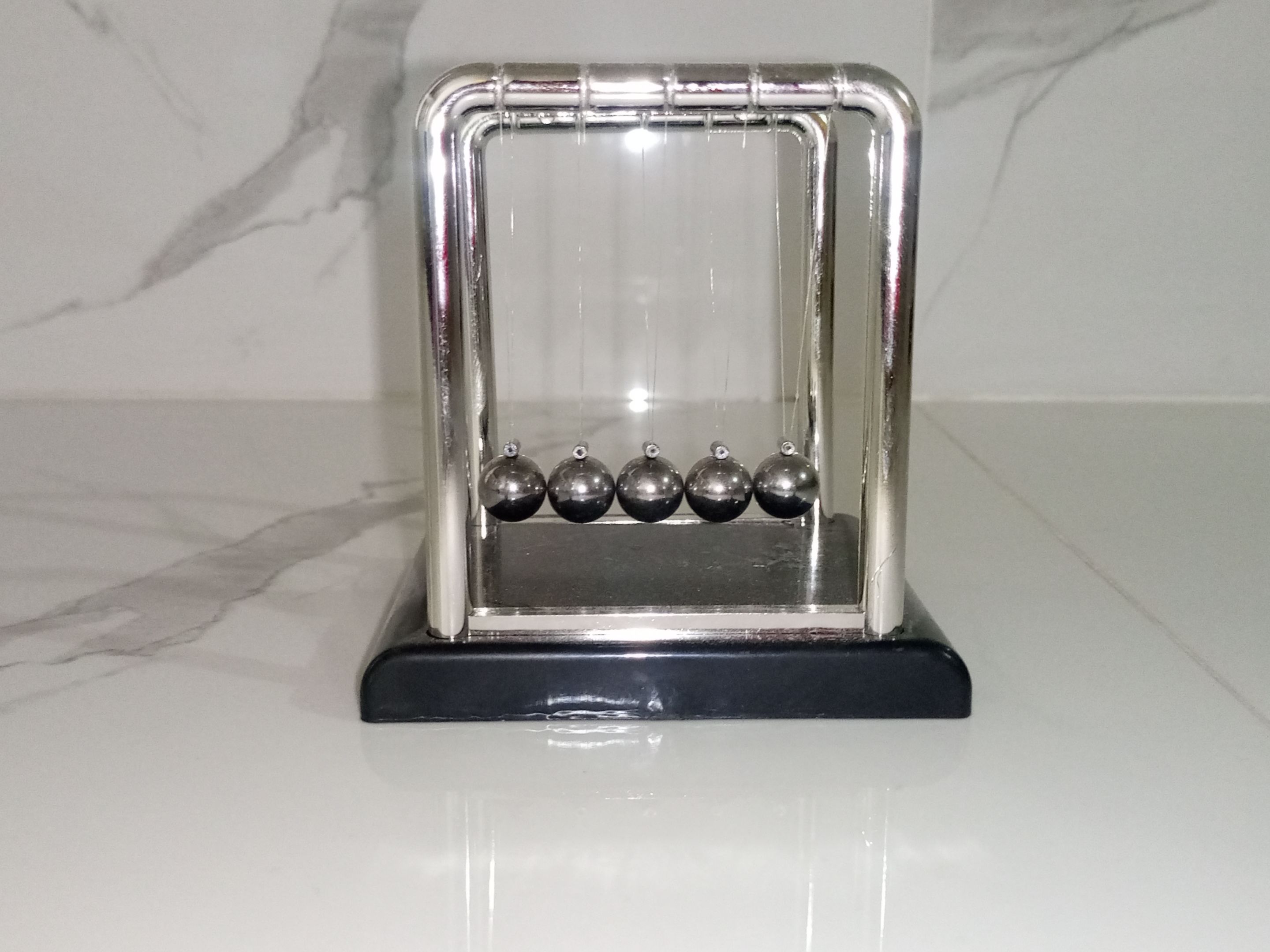
Otra característica importante es que las esferas no deben deformarse, el material utilizado debe ser elástico, ¿cómo funciona? Cuando tomamos la esfera que está al principio del péndulo, la llevamos a una altura dada y nos disponemos a soltar, está esfera volverá a su lugar pero golpeará la siguiente y a su vez a la siguiente, en un momento se observará como la esfera que está en el otro extremo sale disparada, la segunda esfera continuará moviéndose en la dirección del golpe hasta llegar a una altura máxima. Este proceso será repetido durante un rato, pero cada vez la altura de las esferas de los extremos será cada vez menor en comparación con él principio, esto continuará hasta que las esferas vuelvan al reposo.
Another important characteristic is that the spheres must not deform, the material used must be elastic, how does it work? When we take the sphere that is at the beginning of the pendulum, we take it to a given height and we are ready to release, this sphere will return to its place but it will hit the next one and in turn the next one, at a moment it will be observed how the sphere that is at the other end shoots out, the second sphere will continue to move in the direction of the blow until it reaches a maximum height. This process will be repeated for a while, but each time the height of the spheres at the ends will be less and less compared to the beginning, this will continue until the spheres return to rest.
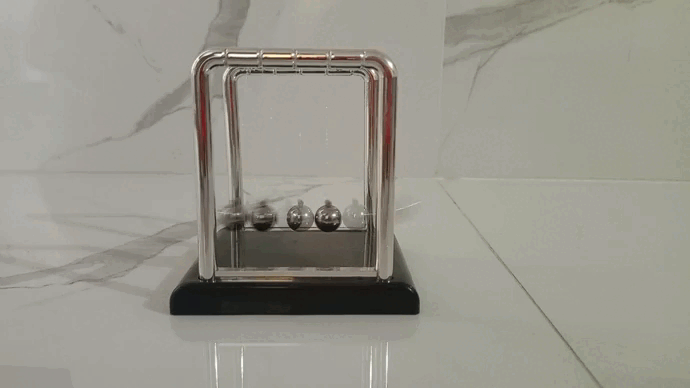
Si por el contrario, tomamos dos esferas simultáneamente las elevamos a una altura cualquiera y las soltamos, el movimiento será parecido al anterior, la diferencia es que en esta ocasión saldrán disparadas las dos esferas que se encuentran en el otro extremo y esto se repetirá durante un momento hasta que las esferas se detengan por completo. Pero, ¿Por qué ocurre esto? Tenemos un agente externo, que en este caso es mi mano, cuando yo cambio de posición la primera esfera esta cambiará su posición con respecto a la Tierra, provocando una ganancia de energía potencial gravitatoria; al momento de soltar la esfera irá perdiendo altura pero ganará velocidad hasta llegar a la parte más baja de su trayectoria, esto quiere decir que perderá la energía potencial gravitatoria, pero gana energía cinética.
If, on the other hand, we take two spheres simultaneously, raise them to any height and release them, the movement will be similar to the previous one, the difference is that this time the two spheres at the other end will shoot out and this will be repeated for a moment until the spheres come to a complete stop. But why does this happen? We have an external agent, which in this case is my hand, when I change the position of the first sphere it will change its position with respect to the Earth, causing a gain of gravitational potential energy; at the moment of releasing the sphere it will lose height but will gain speed until it reaches the lowest part of its trajectory, this means that it will lose gravitational potential energy, but it will gain kinetic energy.
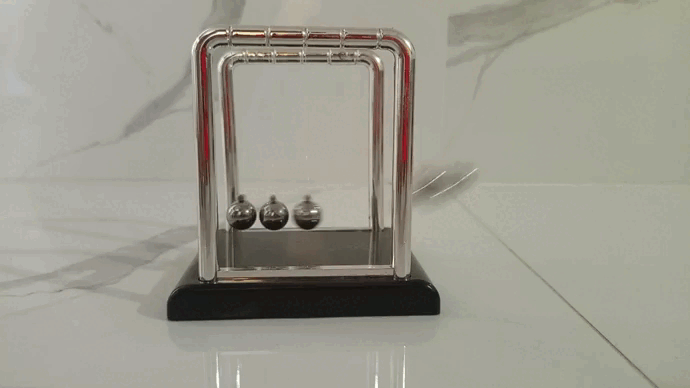
However, it is important to note that when the movement begins the energy will be lost in the form of sound due to the collision of the spheres, but most of the energy is being transferred from sphere to sphere until it reaches the sphere that is last, that is, at the other end, transferring enough energy for it to move. This process will be repeated, gradually losing or wearing out the energy of the system until the spheres return to their resting state.
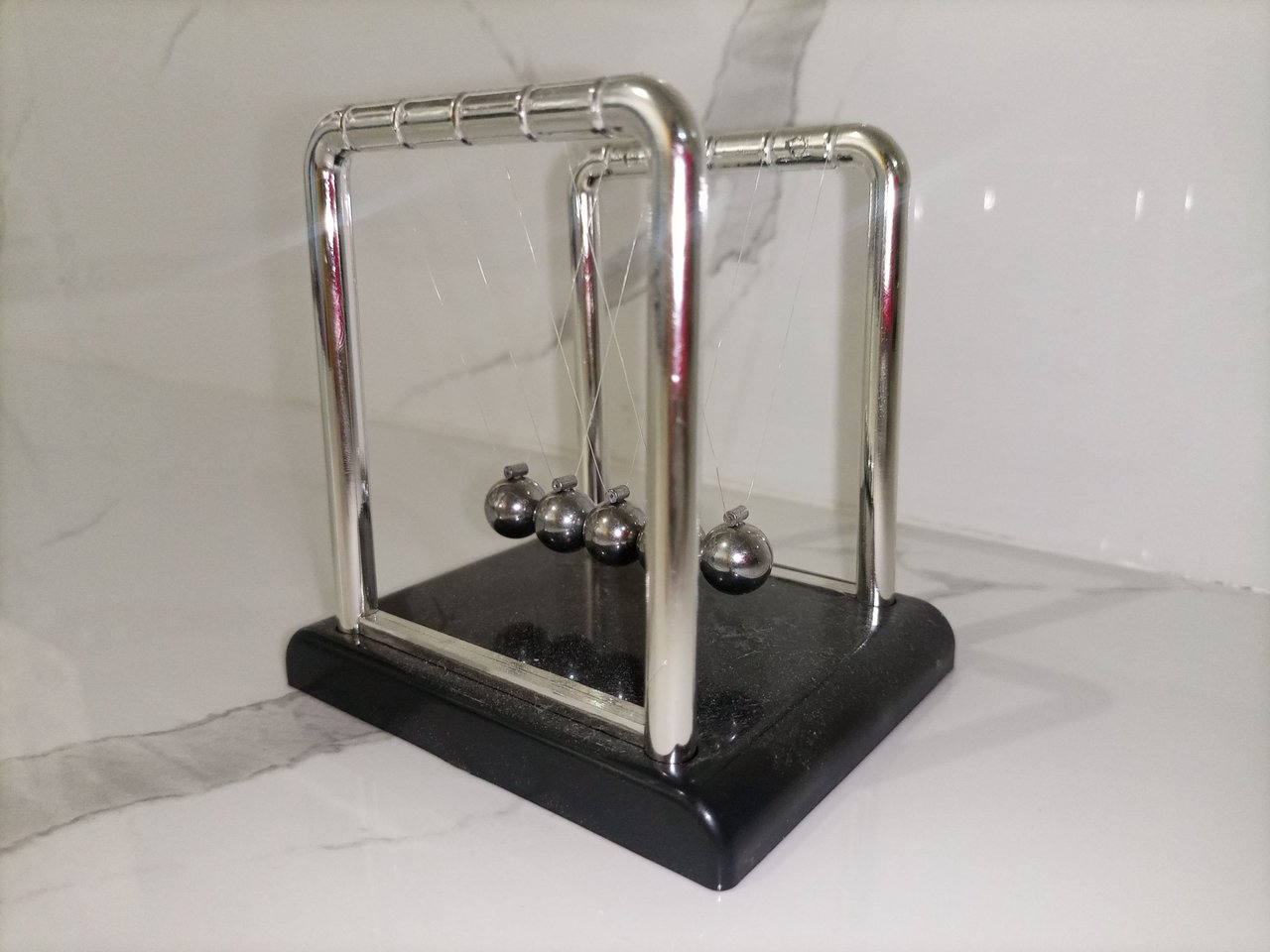
Pero hay otro aspecto sin resolver, ¿Por qué al momento de elevar dos esferas en el otro extremo también se mueven dos esferas? Resulta que dependiendo de la masa del conjunto de esferas y de la velocidad que estás adquieran antes de la colisión, se transferirá una cierta cantidad del movimiento, que es el producto de la masa por la velocidad, pero está se conservará a lo largo del movimiento; de ese modo, que dos esferas les transferirá el impulso a dos esferas. En conclusión podemos decir que:
La energía no se puede ni crear, ni destruir sólo cambiar de una forma a otra.
But there is another unsolved aspect, why at the moment of lifting two spheres at the other end also two spheres move? It turns out that depending on the mass of the set of spheres and the velocity they acquire before the collision, a certain amount of motion will be transferred, which is the product of the mass by the velocity, but it will be conserved throughout the movement; thus, that two spheres will transfer the momentum to two spheres. In conclusion we can say that:
Energy can neither be created nor destroyed, only changed from one form to another.
Ya para despedirme, agradezco a quienes se tomarnos unos minutos de su tiempo para leer mi publicación y me encantaría poder leer en los comentarios sus opiniones e impresiones sobre el tema.
In closing, I would like to thank those of you who took a few minutes of your time to read my publication and I would love to read in the comments your opinions and impressions on the subject.
Referencias
Hewitt, P. (2007). Física Conceptual. México: Pearson Educación.
Serway, R &. (1997). Física Tomo I. México: McGrawHill
Péndulo de Newton: https://www.ecured.cu/P%C3%A9ndulo_de_Newton
Hewitt, P. (2007). Conceptual Physics. Mexico: Pearson Educación.
Serway, R &. (1997). Physics Volume I. Mexico: McGrawHill
Newton's Pendulum: https://www.ecured.cu/P%C3%A9ndulo_de_Newton
Translator Deepl


Posted Using InLeo Alpha
Comments